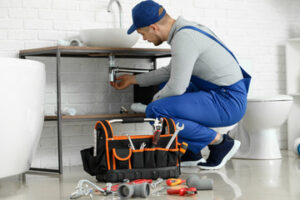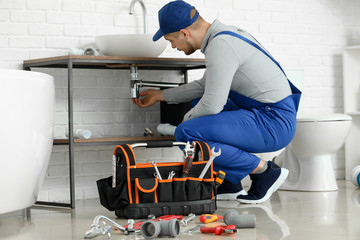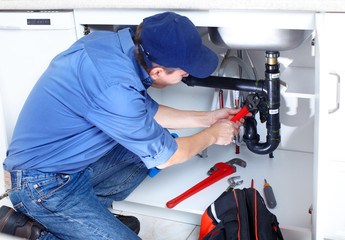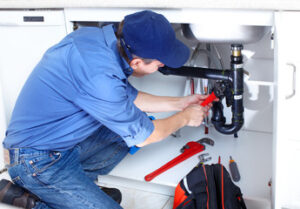Plumbing is the system of pipes, fixtures and appliances that deliver fresh water into homes and safely remove wastewater. It’s important for safe, clean living.
Plumbers work on residential, commercial and industrial settings. They’re in charge of installing, repairing and maintaining plumbing systems to ensure a building’s occupants have access to potable water and safe drainage. Visit https://www.castlerockplumbingllc.com/ to learn more.
 Residential plumbing covers all kinds of maintenance, repair and installation work related to water systems inside private homes and personal residences. These can include kitchens, bathrooms and laundry rooms as well as the pipes and drainage systems that connect them all together. Plumbers who specialize in residential services will often focus on fixing leaky faucets and toilets, unclogging drains and conducting inspections to make sure that water is flowing properly throughout a home’s structure.
Residential plumbing covers all kinds of maintenance, repair and installation work related to water systems inside private homes and personal residences. These can include kitchens, bathrooms and laundry rooms as well as the pipes and drainage systems that connect them all together. Plumbers who specialize in residential services will often focus on fixing leaky faucets and toilets, unclogging drains and conducting inspections to make sure that water is flowing properly throughout a home’s structure.
A residential plumbing system typically consists of two main sets of pipes: the supply pipe and the drain pipe. The supply pipe brings freshwater into the house from outside via a water line, while the drain pipe takes wastewater away through a sewer system or out into the backyard. Each fixture in a residential home – from sinks and showers to water heaters and washing machines – is connected to these pipes through specialized fittings that ensure proper function.
In addition to performing repairs and installations, residential plumbers also offer a range of planning services for new construction projects. Working closely with architects and homeowners, these experts help plan out a home’s plumbing infrastructure before the build begins, ensuring that all new fixtures and appliances are seamlessly integrated into the overall design. This is an important role for plumbers to play, as it allows them to avoid costly mishaps down the road.
Whether working on repairs or new installations, residential plumbers will need to have a wide variety of tools and skills at their disposal in order to service all kinds of fixtures. This includes basic hand tools like wrenches and pliers as well as more specialized power equipment like drain snakes and hydraulic pressure testers. They will also need to have an understanding of building codes and regulations in order to correctly install or repair any kind of plumbing fixture.
In addition to having the right mix of skills and tools, it’s also important for residential plumbers to have a strong customer service mindset in order to keep their clients happy. This means being available around the clock to respond to any emergencies and being willing to go above and beyond to address any concerns that a client may have.
Commercial Plumbing
While water supply systems and sewage draining channels may seem to have the same basic function regardless of property type, there are significant differences between residential and commercial plumbing. This is mainly due to the scale, complexity, and specific requirements of each setting.
Commercial settings typically host a wide range of industries and establishments that each require their own unique setups when it comes to plumbing. These can include retail spaces, office buildings, schools, hospitals, and other public facilities. With the greater number of people occupying each building, a commercial plumbing system is required to handle higher usage rates that can lead to increased wear and tear on fixtures and pipes.
This leads to a need for more durable materials, frequent maintenance, and specialized fixtures designed for specific purposes in each space. In addition, each property must comply with stricter building codes that ensure the safety of all occupants.
In the event of a problem with the plumbing at a commercial facility, it must be addressed quickly to prevent long-term damage and potential health issues for occupants. This is why many companies opt for routine maintenance plans that allow them to monitor the status of their plumbing and catch any problems early on, preventing the need for expensive emergency repairs down the line.
When choosing a plumber for your commercial plumbing needs, be sure to select one who has extensive experience working with different types of commercial structures. This ensures that they understand the intricacies of each unique system and can address any concerns with speed and accuracy. It is also important to choose a licensed plumber who adheres to all relevant laws and regulations.
Commercial plumbing can be complex, but it is essential for ensuring the smooth operation of your business. With the right plumbing partner, you can rest assured that your system will be well-maintained and in compliance with all building codes and regulations. To find out more, contact a trusted professional today. They can provide detailed information about the services they offer, including plumbing installation, maintenance, and repair. Their team of experts will be able to help you find the best solution for your business needs.
Industrial Plumbing
As the name suggests, industrial plumbing deals with the installation and maintenance of plumbing systems in larger non-residential spaces. Industrial settings include everything from hospitals and restaurants to warehouses and manufacturing plants. Industrial plumbing differs from commercial in that it involves the installation of plumbing systems on a larger scale and the servicing of more complex plumbing fixtures. It also typically involves more complex piping systems and a greater degree of system interconnectivity.
For instance, whereas a residential plumber might work on installing or repairing just one toilet or sink in a home, an industrial plumber will likely be involved in the installation of entire plumbing suites in hotels, restaurants, doctor’s offices and other large-scale commercial properties. This includes disabled toilets, urinals, kitchen areas and shower and hand wash facilities. It can also involve implementing intricate water-use control systems to minimise water wastage and optimise water efficiency.
An important aspect of industrial plumbing is compliance with strict safety regulations. This may involve adherence to specific installation guidelines, backflow prevention and fire safety. It can also involve obtaining the necessary permits and conducting regular assessments and inspections.
Additionally, industrial plumbers must be capable of interpreting blueprints and selecting appropriate materials. They must also be proficient at assessing and diagnosing issues to minimise disruptions to business operations. This can be particularly challenging in busy commercial settings, where plumbing problems can have wide-ranging implications.
Another crucial aspect of industrial plumbing is ensuring that water supply and drainage systems meet the specific requirements of the property. For example, in food and hospitality industries, water supply and drainage systems must be able to meet strict health codes and prevent contamination. This can require extensive piping, as well as the use of high-quality, durable materials that can withstand frequent usage and harsh environments.
Additionally, industrial plumbing often requires the servicing of material handling equipment and hydraulic systems. For instance, many factories and manufacturing plants use hydraulic systems to operate heavy machinery like cranes and conveyor belts. These systems are essential to the production process, so any faults can have a significant impact on productivity. In addition, industrial plumbing may also involve the use of specialised chemicals and materials that require special training and certification to handle safely.
Piping
Pipes are long tubes that conduct liquids, gases and sometimes solids. They are an essential component of plumbing, heating and cooling systems as well as industrial processes. The most common use of pipes is distributing potable water and transporting fuels. They are also used to carry chemicals and other industrial fluids. Pipes may also serve structural purposes in construction.
A pipe is typically constructed from metals such as steel, copper, brass or plastic or a combination of these materials. The material selection depends on the type of fluid to be conveyed, the operating pressure and temperature, as well as the environment and system design. Pipes are often reinforced with abrasion resistant or corrosion resistant material to improve their mechanical properties and lifespan.
Piping systems can include a number of in-line components, including valves and sensors that measure and control the flow rate, pressure, temperature, and other factors. Pipes are often assembled in a welded or seamless construction, but they can also be formed in a variety of ways using materials such as glass, fiberglass, or concrete.
The scope of piping and pipelines is defined in the ASME B31.3 Code. Piping refers to interconnected piping and related equipment, while pipelines refer to interconnected hoses, tubing, fittings and similar devices that transport fluids from one point to another. Pipelines can be aboveground or underground and may have a single or multiple lengths. They can also be insulated or coated to protect the fluids from heat or cold or for aesthetic reasons.
Regardless of the location or application, plumbing requires careful planning and installation to ensure that it functions properly. Even with the most meticulous design and construction, however, there is always a chance that something will go wrong. Common plumbing problems include dripping faucets, clogged drains and toilets, and slow or unreliable water flow. Plumbers can troubleshoot these issues and determine the best solutions. In addition to repairing and maintaining pipes, they can also help homeowners prepare for floods and other natural disasters by installing backflow preventers and stormwater diverters. They can also advise homeowners on energy efficient and sustainable plumbing options for their homes or businesses.



